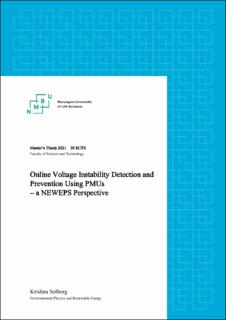| dc.contributor.advisor | Berlijn, Sonja | |
| dc.contributor.author | Solberg, Krishna Øyvard Bjørlin | |
| dc.date.accessioned | 2021-10-05T13:17:50Z | |
| dc.date.available | 2021-10-05T13:17:50Z | |
| dc.date.issued | 2021 | |
| dc.identifier.uri | https://hdl.handle.net/11250/2787790 | |
| dc.description.abstract | As a response to climate change, the EU has set a goal of becoming carbon-neutral by 2050. This requires an increased share of renewable energy across the EU’s economy, including the energy sector. As a result, power systems will increase in complexity and become more vulnerable to instability. Hence, upgrades and improvements to the power system will be necessary for the years to come. The background for this thesis is the Nordic Early Warning Early Prevention System (NEWEPS) project, a comprehensive project set in motion by the Nordic Transmission System Operators (TSOs). The goal of this project is to create a common information system for stability monitoring and improve the current awareness and control systems. The project focuses on several aspects of the power system, where one aspect is voltage instability detection and prevention. Since voltage instabilities in some cases can lead to voltage collapses, it is desirable to have systems that can continuously monitor the system state and warn system operators of instability. A requirement for this to be implemented is the use of Phasor Measurement Units (PMUs), due to their high sampling rate and time synchronization.
In this thesis, a case study was performed as a way of evaluating how the Norwegian power grid corresponds to contingencies, as well as to confirm general voltage stability theory. Here, Power-Voltage (PV) curves were plotted to find the maximum loadability point of two buses in “Sørnettet”, a part of the northern Norwegian power grid. The simulations showed that for the area in focus, the maximum loadability point of the buses was approximately 280 MW when tripping one of three parallel lines. It was also found that a line-tripping closer to the buses resulted in a lower maximum loadability of 205 MW. At the maximum loadability points, the voltages collapsed, which would result in a blackout. Hence, being able to detect when the system is close to these thresholds is critical.
The main goal and research question in this thesis involved risk mitigation of voltage instability and collapse. Consequently, four different types of methods for voltage stability analysis and voltage instability detection and prevention were researched. These were Thévenin Equivalent (TE) models, Machine Learning models (ML), risk matrix assessment and Energy Storage Systems (ESS). Of these four, the TE models were considered most promising and had the highest Technology Readiness Level (TRL). Two different types of TE models were discussed herein, where the dynamic TE model shows the most potential for implementation in the Nordic power system. A state-of-the-art study with a focus on the Nordic power system will hopefully set a starting point for the NEWEPS project.
For any of these methods to be implemented, further research and testing will have to be done. In addition to verifying the performance of the models on the Nordic power system, economic and practical considerations must be taken into account. The NEWEPS project will include a PhD study, which will further analyze and study methods for voltage instability detection and prevention, and perhaps work on implementation. | en_US |
| dc.description.abstract | Som en respons på klimaendringene har EU satt et mål om å være karbon-nøytrale innen 2050. Dette krever en økning i andelen fornybar energi på tvers av EUs økonomi, blant annet innenfor energisektoren. Dette vil føre til høyere kompleksitet i kraftsystemet, og risiko for ustabilitet vil øke. Dermed vil oppgraderinger og forbedringer i strømnettet være nødvendig fremover. Bakgrunnen for denne oppgaven er Nordic EarlyWarning Early Prevention System (NEWEPS)-prosjektet, som er et omfattende prosjekt satt i gang av de nordiske transmisjonssystemoperatorene (TSO). Målet med prosjektet er å lage et felles informasjonssystem for stabilitetsovervåkning og å forbedre de nåværende systemene for oversikt og kontroll. Prosjektet fokuserer på flere aspekter ved kraftsystemet, der ett av dem er oppdaging og forhindring av spenningsustabilitet. Fordi spenningsustabilitet i noen tilfeller kan føre til spenningskollaps, er det ønskelig å ha systemer som kontinuerlig kan overvåke systemtilstanden og advare operatører hvis ustabilitet oppstår. Et krav for at et slikt system skal implementeres er bruken av PMU-er, på grunn av høyere tidsoppløsning og tidssynkronisering.
I oppgaven ble det utført en case-studie for å se hvordan systemet reagerer på en systemfeil. I tillegg blir case-studien sammenlignet med teori om spenningsstabilitet for å undersøke likhetene og eventuelt ulikhetene. I case-studien ble Effekt-Spenning (PV)-kurver plottet for å finne det maksimale lastpunktet til to noder i “Sørnettet”, en del av det nordnorske strømnettet. Simuleringene viste at det maksimale lastpunktet var omtrent 280 MW når én av de tre parallelle linjene ble koblet ut. Det ble også funnet at da en linje nærmere en av nodene ble koblet ut, resulterte det i et lavere maksimalt lastpunkt på 205 MW. Ved de maksimale lastpunktene i alle tilfellene kollapset spenningen, som ville ført til strømbrudd. Å være i stand til å oppdage når systemet er nær disse punktene er derfor meget viktig. | en_US |
| dc.language.iso | eng | en_US |
| dc.publisher | Norwegian University of Life Sciences, Ås | en_US |
| dc.rights | Attribution-NonCommercial-NoDerivatives 4.0 Internasjonal | * |
| dc.rights.uri | http://creativecommons.org/licenses/by-nc-nd/4.0/deed.no | * |
| dc.title | Online voltage instability detection and prevention using PMUs : a NEWEPS perspective | en_US |
| dc.type | Master thesis | en_US |
| dc.description.localcode | M-MF | en_US |

